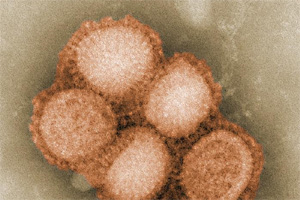 The swine flu virus. Credit: C. S. Goldsmith and A. Balish, CDC.
The swine flu virus. Credit: C. S. Goldsmith and A. Balish, CDC.
As this story is being produced, the reports on swine flu are changing hourly. Cases are popping up closer and closer to home, and the CDC is updating several times a day on the spread of the virus, and plans to fight it.
The $64,000 question is how worried we should be.
Swine flu is largely untreatable: The two effective antiviral drugs, Tamiflu and Relenza, must be taken within 48 hours of infection to stop the spread of the virus.
That leaves a vaccine. Vaccines are relatively straightforward to create, but they take time. If swine flu becomes a deadly pandemic (meaning it's not only widespread -- a pandemic -- but more lethal than it appears to be so far) the demand for vaccines would likely far outpace supply. According to Art Reingold, at UC Berkeley's School of Public Health, it could take years for doses to reach everyone in the world who's vulnerable to the disease. Here in the US, we have very few vaccine producing facilities, which means we'd be competing with other countries' priorities to treat their own citizens.
